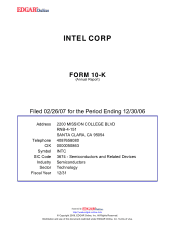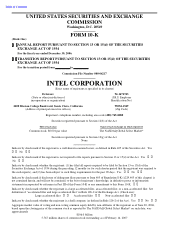Intel 2006 Annual Report Download - page 8
Download and view the complete annual report
Please find page 8 of the 2006 Intel annual report below. You can navigate through the pages in the report by either clicking on the pages listed below, or by using the keyword search tool below to find specific information within the annual report.
Table of Contents
Our microprocessor sales generally have followed a seasonal trend; however, there can be no assurance that this trend will
continue. Historically, our sales of microprocessors have been higher in the second half of the year than in the first half of the
year. Consumer purchases of PCs have been higher in the second half of the year, primarily due to
back-to-school and holiday
demand. In addition, purchases from businesses have tended to be higher in the second half of the year.
The chipset operates as the PC’s “nervous system,” sending data between the microprocessor and input, display, and storage
devices, such as the keyboard, mouse, monitor, hard drive, and CD or DVD drive. Chipsets perform essential logic functions,
such as balancing the performance of the system and removing bottlenecks. Chipsets also extend the graphics, audio, video,
and other capabilities of many systems based on our microprocessors. Finally, chipsets control the access between the CPU
and main memory. We offer chipsets compatible with a variety of industry-accepted bus specifications, such as the
Accelerated Graphics Port (AGP) specification, the Peripheral Components Interconnect (PCI) local bus specification, and the
PCI Express* local bus specification. PCI Express significantly increases the data transfer rate of the original PCI
specification, thereby improving the graphics and input/output bandwidth and enabling an improved multimedia experience.
We believe that our customers also want memory architecture alternatives, and as a result, we offer chipsets supporting double
data rate (DDR) and DDR2 (second-generation, faster DDR memory), dynamic random access memory (DRAM),
synchronous DRAM (SDRAM), and fully buffered dual in-line memory module (FB-DIMM).
A motherboard is the principal board within a system. A motherboard has connectors for attaching devices to the bus, and
typically contains the CPU, memory, and the chipset. We currently offer motherboard products designed for our desktop,
server, and workstation platforms, thereby providing a more complete range of solutions for our customers looking for Intel
®
-
based solutions. We provide our OEM customers with the flexibility to make purchases at the board or at the component level.
Flash memory
is a specialized type of memory component used to store user data and program code; it retains this information
even when the power is off, and provides faster access to data than traditional hard drives. Flash memory has no moving parts,
unlike devices such as rapidly spinning hard drives, allowing flash memory to be more tolerant of bumps and shocks. A
common measure of flash memory performance is the density of the product. Density refers to the amount of information the
product is capable of storing. Flash memory is based on either NOR or NAND architecture. NOR flash memory, with its fast
access or “read” capabilities, has traditionally been used to store executable code. We offer NOR flash memory products such
as Intel StrataFlash
®
wireless memory for mobile phone designs. In addition to product offerings for cellular customers, we
offer NOR flash memory products that meet the needs of other market segments, such as the embedded market segment. The
embedded market segment includes set-top boxes, networking products, DVD players, DSL and cable modems, and other
devices. NAND flash memory is slower in reading data but faster in writing data. We offer NAND flash memory products that
are designed primarily for memory cards, digital audio players, and cellular phones. Our NAND flash memory products are
manufactured by IM Flash Technologies, LLC (IMFT), a company we formed with Micron Technology, Inc. in January 2006.
For further discussion of our equity investment in IMFT, see “Note 17: Venture” in Part II, Item 8 of this Form 10-K.
We offer wired and wireless connectivity products based on industry-standard technologies used to translate and transmit data
in packets across networks. We offer products for the traditional local area network (LAN) environment, as well as for the
wireless LAN (WLAN), metropolitan area network (MAN), and networked storage market segments. For the LAN and MAN
market segments, we offer products at multiple levels of integration to provide a low-cost solution with increased speed and
signal transmission distance (commonly referred to as “reach”). Gigabit Ethernet networks allow the transmission of one
billion individual bits of information per second, and 10-Gigabit Ethernet networks transmit 10 billion bits of information per
second. By contrast, Fast Ethernet networks transmit 100 million bits of information per second (Mbps, or megabits per
second). Our wireless connectivity products are based on either the 802.11 or 802.16 industry standard. The 802.11
communication standard refers to a family of specifications commonly known as WiFi technology. These specifications
describe the bandwidth and frequency of the over-the-air
interface between a wireless client and a base station, or between two
wireless clients. We also have developed and are developing wireless connectivity products for both mobile and fixed
networks based on the 802.16 industry standard, commonly known as WiMAX, which is short for Worldwide Interoperability
for Microwave Access. WiMAX is a standards-based wireless technology providing high-speed, last-mile broadband
connectivity that makes it possible to wirelessly connect end users to networks, as well as networks to other networks, up to
several miles apart.
Communications infrastructure products include network processors, communications boards, and optical transponders that
are basic building blocks for modular communications platforms. These products include advanced, programmable processors
used in networking equipment to rapidly manage and direct data moving across the Internet and corporate networks. Our
modular communications platforms are based on telecommunication industry standards, such as Advanced Telecom
Computing Architecture (AdvancedTCA*) systems and carrier-grade servers, allowing for communications and media
services to be managed independently from the network itself. Unlike proprietary systems platforms, modular communications
platforms are standards-based solutions that offer network infrastructure builders flexible, low-cost, low power consumption
options for designing their networks. We also offer embedded processors that can be used for modular communications
platform applications.
3





















